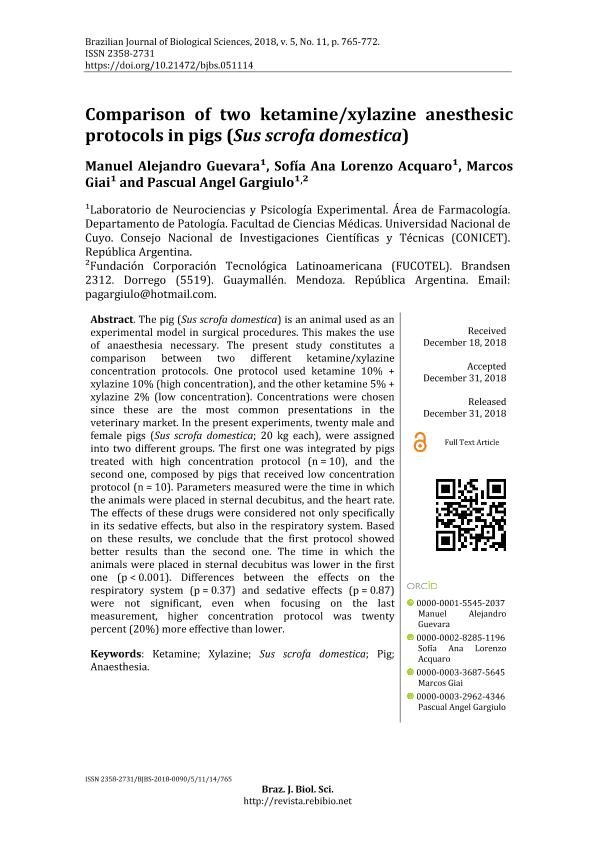Mostrar el registro sencillo del ítem
dc.contributor.author
Guevara, Manuel Alejandro

dc.contributor.author
Lorenzo Aquaro, Sofía Ana
dc.contributor.author
Giai, Marcos

dc.contributor.author
Gargiulo, Pascual Angel

dc.date.available
2020-03-02T17:48:16Z
dc.date.issued
2018-05
dc.identifier.citation
Guevara, Manuel Alejandro; Lorenzo Aquaro, Sofía Ana; Giai, Marcos; Gargiulo, Pascual Angel; Comparison of two ketamine/xylazine anesthesic protocols in pigs (Sus crofa domestica); Rede Brasileira de Informações Biológicas - Rebibio; Brazilian Journal of Biological Sciences; 5; 11; 5-2018; 765-772
dc.identifier.issn
2358-2731
dc.identifier.uri
http://hdl.handle.net/11336/98627
dc.description.abstract
The pig (Sus scrofa domestica) is an animal used as an experimental model in surgical procedures. This makes the use of anaesthesia necessary. The present study constitutes a comparison between two different ketamine/xylazine concentration protocols. One protocol used ketamine 10% + xylazine 10% (high concentration), and the other ketamine 5% + xylazine 2% (low concentration). Concentrations were chosen since these are the most common presentations in the veterinary market. In the present experiments, twenty male and female pigs (Sus crofa domestica; 20 kg each), were assigned into two different groups. The first one was integrated by pigs treated with high concentration protocol (n = 10), and the second one, composed by pigs that received low concentration protocol (n = 10). Parameters measured were the time in which the animals were placed in sternal decubitus, and the heart rate. The effects of these drugs were considered not only specifically in its sedative effects, but also in the respiratory system. Based on these results, we conclude that the first protocol showed better results than the second one. The time in which the animals were placed in sternal decubitus was lower in the first one (p < 0.001). Differences between the effects on the respiratory system (p = 0.37) and sedative effects (p = 0.87) were not significant, even when focusing on the last measurement, higher concentration protocol was twenty percent (20%) more effective than lower.
dc.format
application/pdf
dc.language.iso
eng
dc.publisher
Rede Brasileira de Informações Biológicas - Rebibio
dc.rights
info:eu-repo/semantics/openAccess
dc.rights.uri
https://creativecommons.org/licenses/by-nc-sa/2.5/ar/
dc.subject
Ketamine
dc.subject
Xylazine
dc.subject
Sus scrofa domestica
dc.subject
Pig
dc.subject
Anaesthesia
dc.subject.classification
Neurociencias

dc.subject.classification
Medicina Básica

dc.subject.classification
CIENCIAS MÉDICAS Y DE LA SALUD

dc.title
Comparison of two ketamine/xylazine anesthesic protocols in pigs (Sus crofa domestica)
dc.type
info:eu-repo/semantics/article
dc.type
info:ar-repo/semantics/artículo
dc.type
info:eu-repo/semantics/publishedVersion
dc.date.updated
2020-01-29T22:34:27Z
dc.journal.volume
5
dc.journal.number
11
dc.journal.pagination
765-772
dc.journal.pais
Brasil

dc.journal.ciudad
Joao Pessoa
dc.description.fil
Fil: Guevara, Manuel Alejandro. Universidad Nacional de Cuyo. Facultad de Ciencias Médicas; Argentina. Consejo Nacional de Investigaciones Científicas y Técnicas; Argentina
dc.description.fil
Fil: Lorenzo Aquaro, Sofía Ana. Consejo Nacional de Investigaciones Científicas y Técnicas; Argentina. Universidad Nacional de Cuyo. Facultad de Ciencias Médicas; Argentina
dc.description.fil
Fil: Giai, Marcos. Universidad Nacional de Cuyo. Facultad de Ciencias Médicas; Argentina. Consejo Nacional de Investigaciones Científicas y Técnicas; Argentina
dc.description.fil
Fil: Gargiulo, Pascual Angel. Consejo Nacional de Investigaciones Científicas y Técnicas. Centro Científico Tecnológico Conicet - Mendoza; Argentina. Universidad Nacional de Cuyo. Facultad de Ciencias Médicas; Argentina. Fundación Corporación Tecnológica Latinoamericana; Argentina
dc.journal.title
Brazilian Journal of Biological Sciences
dc.relation.alternativeid
info:eu-repo/semantics/altIdentifier/doi/http://dx.doi.org/10.21472/bjbs.051114
Archivos asociados
